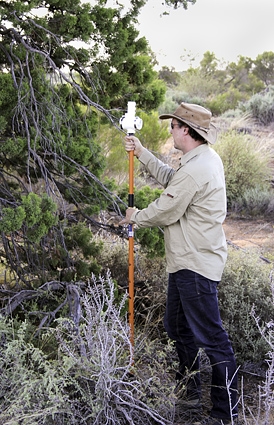Measuring vegetation at Calperum … By using the point intercept method to sample vegetation at 1,000 points and 4,000 points across a hectare, TREND has determined that the smaller number is enough to adequately describe a plot.
TERN is helping to give students the skills to participate in the real world of professional science — several scholarships granted to students to work on the Transects for Environmental Monitoring and Decision Making (TREND) program are reaping benefits for everyone involved.
Five postgraduate students and three post-doctoral researchers have put in time at TREND in two areas: traditional academic research, and the application of academic learning in the field. TREND Program Manager Mr Stefan Caddy-Retalic said that, most recently, TREND had offered three scholarships to undergraduate students to supplement their classroom learning with invaluable field experience over the summer holidays.
‘The arrangement benefits us, and the students and post-docs,’ Stefan says.
‘For example, one student at the end of her second undergraduate year was unsure whether she wanted to focus on geology or ecology for the rest of her degree. We were able to work with her to design a project that gave her a lot of exposure to TERN’s soil programs and allow her to experience the field work a professional pedologist might do. The work she did for us gave her a solid grounding in what to expect in the field, and gave her practical skills which will help her be more competitive professionally or in further study.’
Traditional PhD scholarships have also benefited TREND and the student. Recently graduated PhD candidate Dr Fran MacGillivray studied changes in the flowering time of orchids. The work helped her get her doctorate, and at the same time it added depth to TREND’s knowledge of its core business, understanding how species and ecosystems change over time. Post-doctoral fellow Dr Greg Guerin’s study of changes in leaf size has also been mutually beneficial. Honours student Ms Kimberly McCallum used her scholarship to investigate genetic diversity in high-altitude pockets of Callistemon species, research that can be used by conservationists and policymakers to determine which are the most important to protect. Dr Martin Breed’s recently completed PhD research on the genetic health of trees in fragmented landscapes will be picked up commercially, by companies sourcing seed for conservation planting.
TREND has also supported students to gain valuable experience in the field, extending their theoretical knowledge with experience of how to employ it in solving problems when working on the ground on TREND transects.
TREND and AusPlots Rangelands awarded two summer scholarships to students to test the validity of the AusPlots Rangelands survey methodology. One student recorded the vegetation at 4,000 points across several one hectare AusPlots plots, and they were compared with the 1,000 normally collected. The results allowed TERN scientists to determine that 1,000 points is enough to reliably describe the vegetation community at a plot. Another student, Mr Nick Gellie, used a differential GPS and repeated from scratch the location and measurement of an AusPlot plot several times to find out whether the location and layout of the plot was repeatable, or whether it might contribute to variation in data collected. The student found the technique was robust, and didn’t significantly affect measurements.
‘The projects TREND offered are strongly field-based,’ Nick says.
‘We have accrued great experience and this helps to make us more credible applicants when we’re applying for projects and future work.’
Stefan agrees: ‘We have noticed a big change in the students we’ve been working with. They are now more confident and better prepared to do field-based research, and they can hit the ground running on future projects.’
TREND also runs active citizen science programs, which amateur naturalists enjoy because they can take part in real scientific research, and which helps TREND accumulate data it otherwise wouldn’t have the funds to collect.
Published in TERN e-Newsletter April 2013







